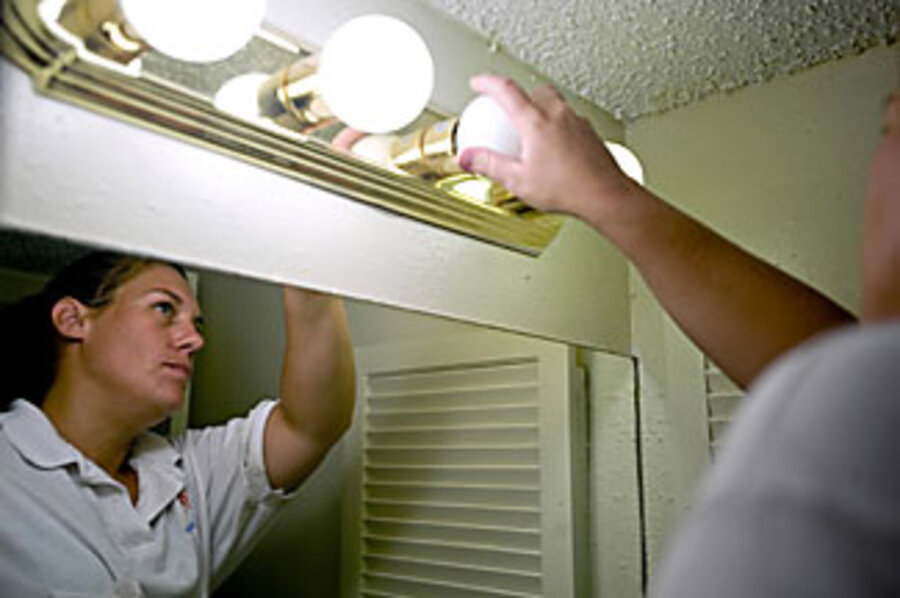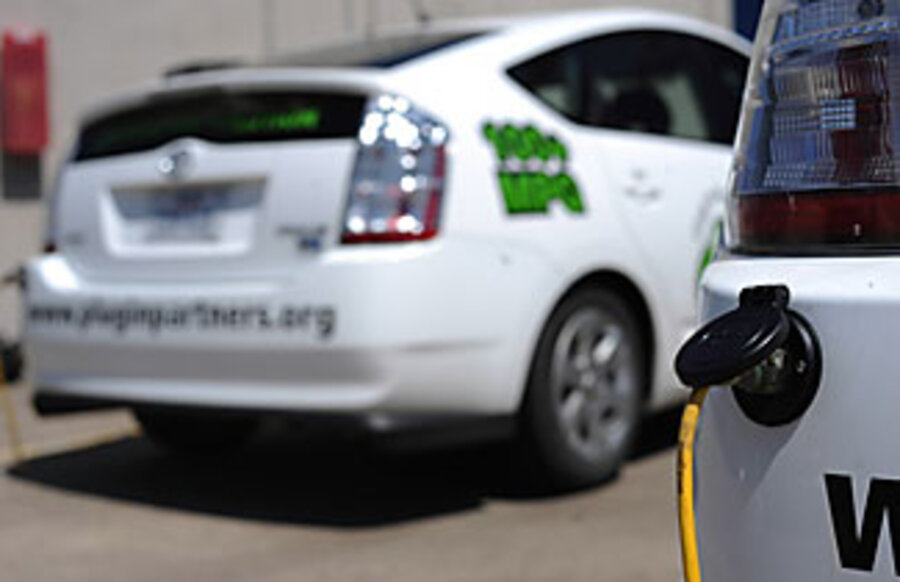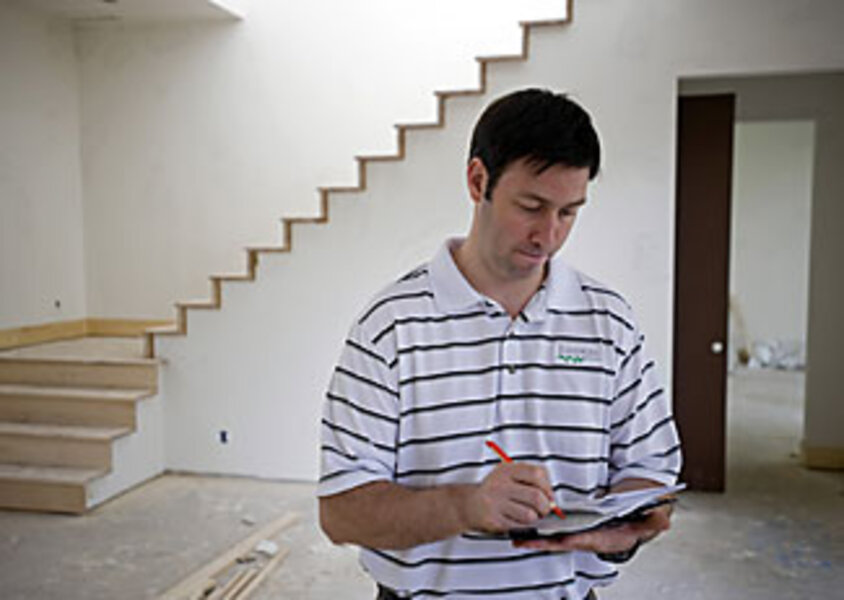Texas test case for candidates' energy plans
Loading...
| Austin, Texas
As part of his solution to America's energy woes, Barack Obama wants to phase out the common light bulb in six years.
The Democratic senator's solution – under current law they phase out in 12 years – is taking place here where a city contractor is busy replacing incandescent bulbs with energy-saving compact fluorescent models. The goal: reduce power consumption so the city doesn't have to build another power plant.
John McCain's energy proposals include nudging Detroit to build vehicles more quickly that run on multiple fuels, such as ethanol or biodiesel.
The Republican senator's solution is also taking place here, where city vehicles can use one of six alternative fuels instead of conventional gasoline. The city's goal: lower greenhouse-gas emissions.
Welcome to the sweltering laboratory for some of the energy solutions proposed by both candidates in an election year when the economy and energy are the top issue for voters. For months – including this week – the candidates have been sniping away at each other over gasoline taxes, energy rebates, and offshore oil drilling.
Like many of the candidates' ideas, some of Austin's plans won't have an immediate effect – it could be 10 years or more until some of the efforts reduce the city's energy consumption in part because the technology is just not sufficient yet. But other ideas, such as a real push for conservation, are already paying dividends, reducing some of the need to build new power plants. In some cases, the city has thought about some of the candidates' proposals and already rejected them.
The basic thrust of the McCain approach is to encourage private enterprise, via tax incentives and other lures, to solve the problem. He sees energy as a national-security issue and wants to encourage more production of oil. Senator Obama's push is for a stronger Washington hand combined with new technology. He wants to break the United States of the oil "habit."
Nationally, the energy challenge for the candidates is Texas-size.
Every day, the US consumes 20.6 million barrels of oil, burning through $125 million an hour. Emissions of carbon dioxide are up 19.3 percent from 1990 to 2006. And neither candidate can get around the fact that the price of gasoline is way up over last year.
The economy is the No. 1 issue for voters this year, say pollsters. And for the pocketbook as well as for policy, energy leads economic concerns. "It will be a key driver to decide who wins," says Dennis Jacobe, Washington-based chief economist for the Gallup Organization.
In some ways Austin is ideal as a lab for clean energy: The city is the capital of the nation's most polluting state.
If Texas were a country, it would be the sixth most polluting nation on the planet, just ahead of Canada, says Austin's mayor, Will Wynn. "We are not only No. 1 in terms of carbon emissions, we emit more carbon than No. 2 California and No. 3 Pennsylvania combined."
Moreover, Austin's energy mix, supplied by a city-owned utility, is relatively close to the nation's power supply. Austin Energy, the municipal utility, gets 35 percent of its energy from low-sulfur coal (50 percent nationally), 29 percent from natural gas (20 percent nationally), almost 26 percent from nuclear (20 percent), and 8 percent from renewables (3 percent).
Austin has set a goal of being carbon neutral (removing as much carbon as the city is adding) for all city-owned vehicles, buildings, and operations by 2020. Technology for elimination of all carbon emissions may not be possible by then, so Austin is studying offset strategies – such as planting trees or prairie grass – that can remove the remaining emissions.
One way the city is trying to lower carbon emissions – an effort suggested by both candidates – is the use of flex-fuel vehicles.
Senator McCain would jawbone auto manufacturers to make more vehicles that run on various types of fuel. That's actually happening in Austin where a city fueling depot gives city vehicles the option of six different fuels. Some of the options are less expensive than gasoline, such as propane, which costs about $1.90 a gallon, says Will O'Connor, a fleet and fuel manager.
But, for the most part, the main advantage of the flex-fuel fleet is a reduction in greenhouse-gas emissions, he says. "Some of the alternative fuels result in 30 percent less carbon per mile than regular gasoline," he says as he watches a tanker at the depot unload biodiesel made from cotton seeds.
Mayor Wynn, a Democrat, has talked energy in person with both candidates. He says he has "steered" Obama's advisers to programs the city is enacting. And, two years ago, he met with McCain, whom he calls "a breath of fresh air" for his interest in the environment.
Both candidates envision major investments in "clean coal" technology that turns carbon from coal into gas through a chemical process. The gas may get stored underground or deep in the ocean. So far, the technology for storage has not been proven. McCain proposes spending $2 billion annually for the next three years on developing this technology. Obama says he will "significantly" increase the resources devoted to the technology.
Between now and 2020, Austin is not planning on clean-coal technology to help it reduce its emissions. "We do not see that technology being available for actual commercial use in the next decade at least, possibly longer," says Roger Duncan, general manager of Austin Energy.
McCain is proposing to build 45 new nuclear power plants by 2030, with the ultimate goal of constructing 100 of them. Obama foresees a role for nuclear power plants but first wants to sort out controversial issues such as long-term storage of radioactive waste. Unlike McCain, Obama opposes using Yucca Mountain in Nevada as a repository for such waste.
Austin is already a partner in a nuclear power plant in Bay City, Texas. But the city turned down participation in the expansion of the facility for financial reasons.
Both candidates are also planning on some form of cap-and-trade legislation, a system of setting a limit on carbon emissions and allowing companies to buy and sell the right to emit, Several bills are being considered in Congress.
Wynn estimates that cap and trade, which he favors, could cost Austin Energy as much as $2 billion for the right to burn carbon, depending on which version Congress passes. In a worst-case scenario, this would cost residents 13 to 20 percent more for their electricity. "I tell people we have to stop acting as if climate protection doesn't cost anything," he says. "Price signals are how we change habits."
Both candidates envision a nation turning increasingly to renewable sources of energy. That's already happening in Austin through the use of wind generators located in west Texas. By the end of this year, the city utility will expand its green power from 8 percent to 11 percent of the total – mostly from wind.
The problem with using Texas wind is that it mainly blows between 10 p.m. and 3 a.m. Austin Energy has purchased a Toyota Prius with a special plug-in kit. Right now it's trying to time charging the car with when the wind is blowing.
Eventually, the hybrids may plug back into the system when they are parked, adding electricity back into the system.
How the experiment goes in Austin will be important because both candidates want to see an increase in plug-in vehicles. McCain, in fact, is proposing a $300 million prize for a new battery that will "leapfrog" commercially available plug-ins. McCain will give a tax break that depends on the amount of carbon emissions removed from each vehicle.
The city is also installing "smart meters," endorsed by both candidates. Starting at seven in the morning, installer Brian Evans rings doorbells to tell homeowners he's there to replace their old electric meters with digital versions that will radio the electric charges to a computer.
"You won't need a meter reader anymore," he tells homeowners before he disconnects their power for a few seconds.
Digital meters may also be the foundation for a "smart" electric grid so homes with solar cells can sell power back. But a smart grid has even greater potential. For example, Austin has installed 70,000 radio-controlled digital thermostats in homes. When it needs to reduce its electrical load, it signals units to shut off the air conditioning for 10 minutes.
"It drops demand by 25 to 40 megawatts, enough to eliminate the need for a gas turbine," says Mr. Duncan.
But Austin's most successful effort so far is in energy conservation, a major goal for Obama but mentioned in McCain's proposals only as "common sense conservation." Duncan estimates such efforts have reduced electrical demand by about 700 megawatts, which is equal to a medium-sized coal-fired power plant.
The conservation ethic extends to Austin's new housing codes, which mandate that by 2015 all new residential buildings must be zero energy capable – that is, consume no more energy in a year than they produce. Obama would give builders until 2030.
In Austin's case, this means homes built in 2015 will be up to 70 percent more energy efficient than homes built in 2007 and earlier. The remaining 30 percent would be achieved by on-site generation such as solar panels.
How this is working in Austin can be seen in how home builder Matt Risinger is erecting a 2,830-square-foot home that will get him close to the city's new code. As carpenters work around the site, he shows his metal roof (a radiant heat barrier), spray foam insulation that will keep the attic at 80 degrees F. on the hottest day versus 130 degrees, and superefficient heating and cooling systems.
"My big thing is doing everything possible to make this house as energy efficient as possible," he says.
To reduce electricity demand, Austin Energy has given out coupons for compact fluorescent light bulbs and will pay a significant amount of a homeowner's conservation efforts. Sometimes the city does the work free of charge.
That's happening on a hot day in July at an apartment complex, where project manager Gerald Elrod of Advanced Energy Services arrives with a crew. While one of them replaces incandescent bulbs with lower-energy compact fluorescent models, he begins to patch up the leaky central air-conditioning system.
"We've had grandmothers come up and kiss us for cutting their electric bills in half," he says.







